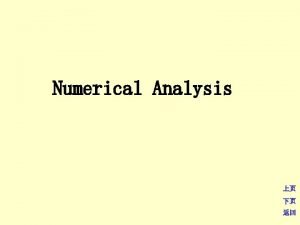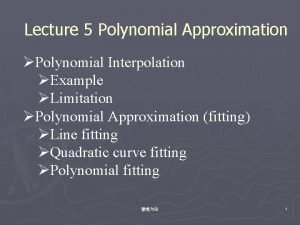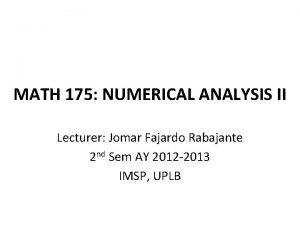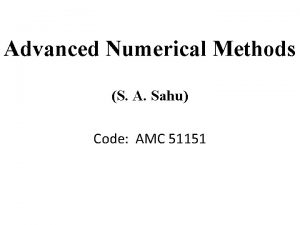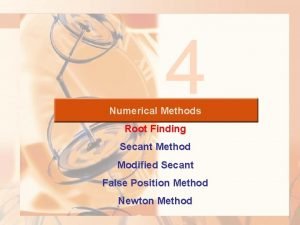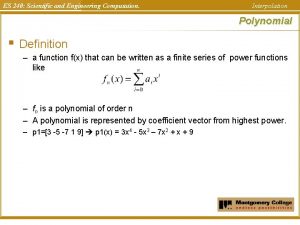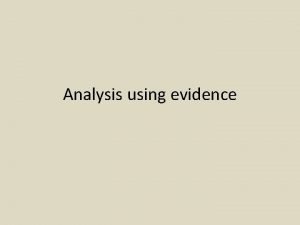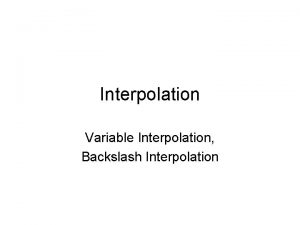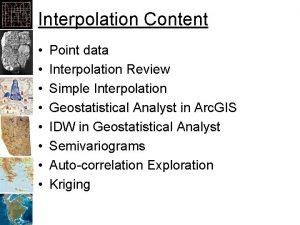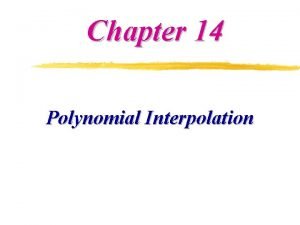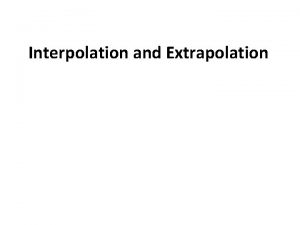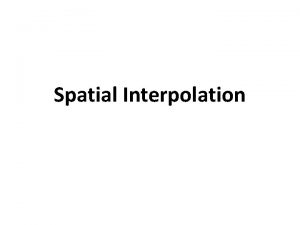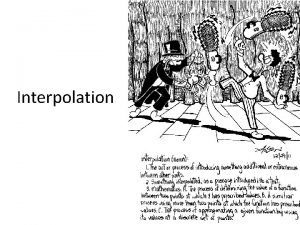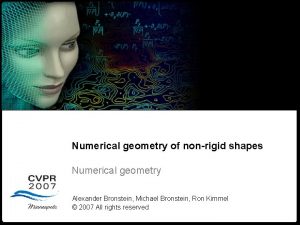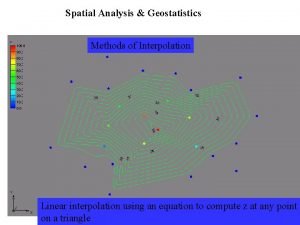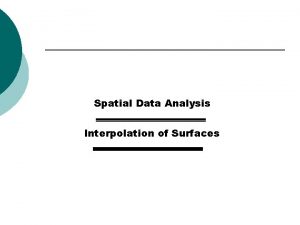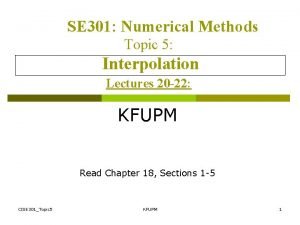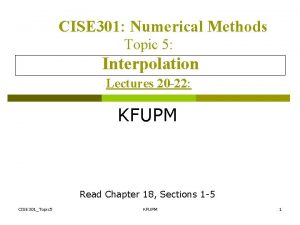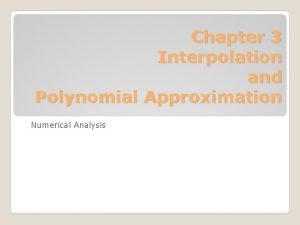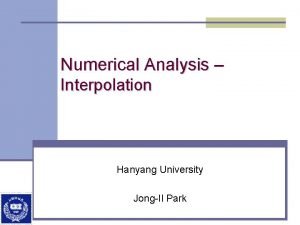Numerical Analysis TOPIC Interpolation DEFINITION Interpolation is the





























































- Slides: 61

Numerical Analysis

TOPIC Interpolation

DEFINITION Interpolation is the process of estimating the value of function for any intermediate value of the variable with the help of its given set of values. Let us assume that the function y=f(x) is known for certain values of x say a for x 0, x 1, x 2, ………xn. As f(x 0), f(x 1), ……. . f(xn). The process of finding the value of f(x) corresponding to x=xi. Where x 0<xi<xn. With the help of given data is called interpolation.

TYPES OF INTERPOLATION

1. Finite Difference Operators 2. Newton’s Forward Difference Interpolation Formula 3. Newton’s Backward Difference Interpolation Formula 4. Lagrange’s Interpolation Formula

rth kth forward difference backward difference

Thus Similarly

Shift operator, E

The inverse operator is defined as Similarly, -1 E

Average Operator,

Differential Operator, D

Important Results

Newton’s Forward Difference Interpolation Formula

Let y = f (x) be a function which takes values f (x 0), f (x 0+ h), f (x 0+2 h), …, corresponding to various equispaced values of x with spacing h, say x 0, x 0 + h, x 0 + 2 h, …. Suppose, we wish to evaluate the function f (x) for a value x 0 + ph, where p is any real number, then for any real number p, we have the operator E such that


This is known as Newton’s forward difference formula for interpolation, which gives the value of f (x 0 + ph) in terms of f (x 0) and its leading differences.

This formula is also known as Newton-Gregory forward difference interpolation formula. Here p=(x-x 0)/h. An alternate expression is

Example: Find a cubic polynomial in x which takes on the values -3, 3, 11, 27, 57 and 107, when x = 0, 1, 2, 3, 4 and 5 respectively.

Solution: Here, the observations are given at equal intervals of unit width. To determine the required polynomial, we first construct the difference table

Difference Table

Since the 4 th and higher order differences are zero, the required Newton’s interpolation formula

Here,

Substituting these values into the formula, we have The required cubic polynomial.

NEWTON’S BACKWARD DIFFERENCE INTERPOLATION FORMULA

For interpolating the value of the function y = f (x) near the end of table of values, and to extrapolate value of the function a short distance forward from yn, Newton’s backward interpolation formula is used

Derivation: Let y = f (x) be a function which takes on values f (xn), f (xn-h), f (xn-2 h), …, f (x 0) corresponding to equispaced values xn, xn-h, xn-2 h, …, x 0. Suppose, we wish to evaluate the function f (x) at (xn + ph),

where p is any real number, then we have the shift operator E, such that Binomial expansion yields,

That is,

This formula is known as Newton’s backward interpolation formula. This formula is also known as Newton’s-Gregory backward difference interpolation formula.

If we retain (r + 1)terms, we obtain a polynomial of degree r agreeing with f (x) at xn, xn-1, …, xn-r. Alternatively, this formula can also be written as

Example: For the following table of values, estimate f (7. 5).

Solution: The value to be interpolated is at the end of the table. Hence, it is appropriate to use Newton’s backward interpolation formula. Let us first construct the backward difference table for the given data

Difference Table

Since the 4 th and higher order differences are zero, the required Newton’s backward interpolation formula is

In this problem,

Example: The sales for the last five years is given in the table below. Estimate the sales for the year 1979

Solution: Newton’s backward difference table for the given data as -3

In this example, and

Newton’s interpolation formula gives Therefore,

LAGRANGE’S INTERPOLATION FORMULA

Newton’s interpolation formulae developed earlier can be used only when the values of the independent variable x are equally spaced. Also the differences of y must ultimately become small.

If the values of the independent variable are not given at equidistant intervals, then we have the basic formula associated with the name of Lagrange which will be derived now.

DERIVATION: Let y = f (x) be a function which takes the values, y 0 , y 1 , …yn corresponding to x 0 , x 1, …xn. Since there are (n + 1) values of y corresponding to (n + 1) values of x, we can represent the function f (x) by a polynomial of degree n.

Suppose we write this polynomial in the form. or in the form

Here, the coefficients ak are so chosen as to satisfy this equation by the (n + 1) pairs (xi, yi). Thus we get Therefore,

Similarly, we obtain and

Substituting the values of a 0, a 1, …, an we get The Lagrange’s formula for interpolation

This formula can be used whether the values x 0, x 2, …, xn are equally spaced or not. Alternatively, this can also be written in compact form as

Where, We can easily observe that, and Thus introducing Kronecker delta notation

Example: Find Lagrange’s interpolation polynomial fitting the points y(1) = -3, y(3) = 0, y(4) = 30, y(6) = 132. Hence find y(5).

Solution: The given data can be arranged as

Using Lagrange’s interpolation formula, we have

On simplification, we get which is required Lagrange’s interpolation polynomial. Now, y(5) = 75.

Example: Given the following data, evaluate f (3) using Lagrange’s interpolating polynomial.

Solution: - Using Lagrange’s formula,

Therefore

ASSIGNMENT 1. Evaluate : (x. log x) 2. Evaluate : (sin 2 x. cos 4 x) 3. Estimate the missing term: x 0 1 2 3 4 Y 1 3 9 _ 81

4. Derive newton forward formula for interpolation. 5. Derive newton backward formula for interpolation.

TEST NOTE: DO ANY TWO

1. Evaluate (x 2+sinx) , the interval of difference being . 2. Find the lowest degree polynomial which satisfies the following table: X 0 1 2 3 4 5 F(x) 0 3 8 15 24 35

3. The population of a town is as follow: YEAR 1961 POPULATION 20 1971 1981 1991 2001 2011 24 35 40 42 51
 Newton backward interpolation formula
Newton backward interpolation formula Newton central difference interpolation formula
Newton central difference interpolation formula Cubic hermite interpolation
Cubic hermite interpolation Spline interpolation vs polynomial interpolation
Spline interpolation vs polynomial interpolation Example of a clincher
Example of a clincher Topic about internet
Topic about internet Graphical and numerical methods
Graphical and numerical methods Numerical analysis formula
Numerical analysis formula Types of errors in numerical computation
Types of errors in numerical computation Stirling interpolation formula
Stirling interpolation formula Secant method numerical method
Secant method numerical method C programming lectures
C programming lectures Integration example
Integration example Numerical analysis
Numerical analysis Numerical expression definition
Numerical expression definition Interpolation definition science
Interpolation definition science Hát kết hợp bộ gõ cơ thể
Hát kết hợp bộ gõ cơ thể Slidetodoc
Slidetodoc Bổ thể
Bổ thể Tỉ lệ cơ thể trẻ em
Tỉ lệ cơ thể trẻ em Voi kéo gỗ như thế nào
Voi kéo gỗ như thế nào Chụp tư thế worms-breton
Chụp tư thế worms-breton Chúa yêu trần thế
Chúa yêu trần thế Các môn thể thao bắt đầu bằng tiếng đua
Các môn thể thao bắt đầu bằng tiếng đua Thế nào là hệ số cao nhất
Thế nào là hệ số cao nhất Các châu lục và đại dương trên thế giới
Các châu lục và đại dương trên thế giới Công thức tính độ biến thiên đông lượng
Công thức tính độ biến thiên đông lượng Trời xanh đây là của chúng ta thể thơ
Trời xanh đây là của chúng ta thể thơ Mật thư tọa độ 5x5
Mật thư tọa độ 5x5 101012 bằng
101012 bằng Phản ứng thế ankan
Phản ứng thế ankan Các châu lục và đại dương trên thế giới
Các châu lục và đại dương trên thế giới Thơ thất ngôn tứ tuyệt đường luật
Thơ thất ngôn tứ tuyệt đường luật Quá trình desamine hóa có thể tạo ra
Quá trình desamine hóa có thể tạo ra Một số thể thơ truyền thống
Một số thể thơ truyền thống Cái miệng xinh xinh thế chỉ nói điều hay thôi
Cái miệng xinh xinh thế chỉ nói điều hay thôi Vẽ hình chiếu vuông góc của vật thể sau
Vẽ hình chiếu vuông góc của vật thể sau Thế nào là sự mỏi cơ
Thế nào là sự mỏi cơ đặc điểm cơ thể của người tối cổ
đặc điểm cơ thể của người tối cổ Giọng cùng tên là
Giọng cùng tên là Vẽ hình chiếu đứng bằng cạnh của vật thể
Vẽ hình chiếu đứng bằng cạnh của vật thể Vẽ hình chiếu vuông góc của vật thể sau
Vẽ hình chiếu vuông góc của vật thể sau Thẻ vin
Thẻ vin đại từ thay thế
đại từ thay thế điện thế nghỉ
điện thế nghỉ Tư thế ngồi viết
Tư thế ngồi viết Diễn thế sinh thái là
Diễn thế sinh thái là Dot
Dot Các số nguyên tố là gì
Các số nguyên tố là gì Tư thế ngồi viết
Tư thế ngồi viết Lời thề hippocrates
Lời thề hippocrates Thiếu nhi thế giới liên hoan
Thiếu nhi thế giới liên hoan ưu thế lai là gì
ưu thế lai là gì Hổ đẻ mỗi lứa mấy con
Hổ đẻ mỗi lứa mấy con Khi nào hổ con có thể sống độc lập
Khi nào hổ con có thể sống độc lập Sơ đồ cơ thể người
Sơ đồ cơ thể người Từ ngữ thể hiện lòng nhân hậu
Từ ngữ thể hiện lòng nhân hậu Thế nào là mạng điện lắp đặt kiểu nổi
Thế nào là mạng điện lắp đặt kiểu nổi Tea paragraph
Tea paragraph How to write a poem analysis
How to write a poem analysis Topic sentence evidence analysis
Topic sentence evidence analysis Joint sentiment topic model for sentiment analysis
Joint sentiment topic model for sentiment analysis


